Article Highlights
- Gabbro is a coarse-grained, intrusive igneous rock, primarily composed of plagioclase and augite. It is predominantly black or dark green in color.
- Gabbro is a key component of the Earth’s oceanic crust and forms from the solidification of iron and magnesium-rich mafic magma.
- Its naming history traces back to the 1760s in the Apennine Mountains of Italy. Today, the term includes various rock types.
- Gabbro’s rich composition and formation contribute to its versatility in various applications like construction, design, and even ore extraction.
To appreciate gabbro, it’s essential to understand what it is and how it forms. This rock doesn’t just appear overnight. Instead, it’s the result of a fascinating journey involving heat, pressure, time, and natural geological processes that have been occurring for billions of years.
The Story Behind the Name

Our tale starts in the 1760s with the term “gabbro” used to denote rock types found in the ophiolites of the Apennine Mountains in Italy. Specifically, the term was named after Gabbro, a hamlet near Rosignano Marittimo in Tuscany.
Fast forward to 1809, and enter the German geologist Christian Leopold von Buch. Von Buch used the term in a more restrictive sense when describing these Italian ophiolitic rocks. He assigned the term “gabbro” to rocks that today we’d probably call “metagabbro” (metamorphosed gabbro).
What Makes up Gabbro? A Look into the Minerals
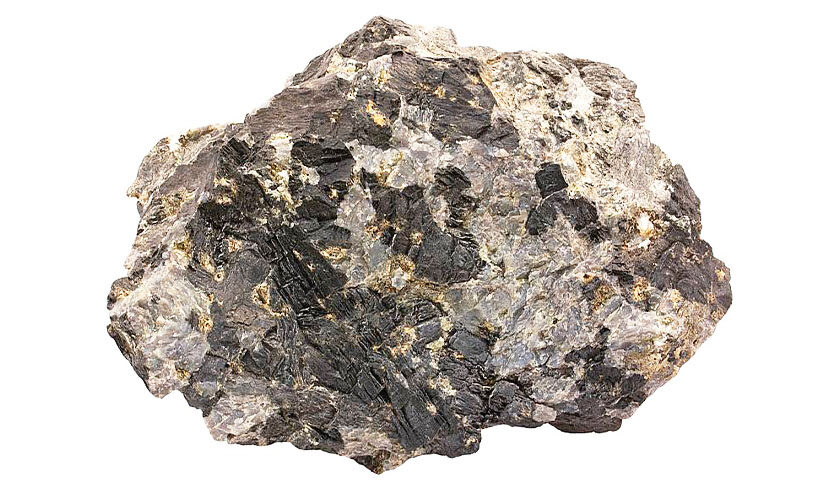
Gabbro’s distinctive appearance comes from a particular blend of minerals. Predominantly, it consists of calcium-rich plagioclase feldspar (usually labradorite or bytownite) and pyroxenes (typically augite). Sometimes you’ll spot minor amounts of olivine in there, too. This blend usually gives gabbro its characteristic black to very dark green color, with a minor amount of light-colored mineral grains also present. And, unlike many other igneous rocks, gabbro usually contains little quartz.
The Formation Journey of Gabbro
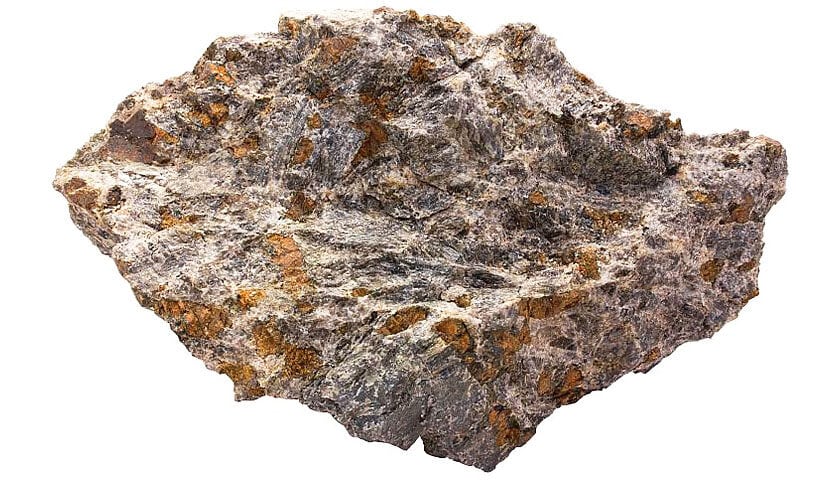
Gabbro’s journey to existence is quite a thrill! It all starts with the solidification of mafic magma, which is rich in iron and magnesium. This magma forms at relatively deep levels within the Earth’s crust or upper mantle. The formation of gabbro follows several key stages:
- Magma generation: Gabbro forms from the partial melting of the mantle or lower crust, typically linked with tectonic processes like mantle upwelling, subduction, or continental rifting. The result? Mafic magma, rich in iron and magnesium, generated from the melting of mantle or crustal rocks.
- Magma migration: Once formed, this magma, lighter than the surrounding rocks, begins its upward journey towards the Earth’s surface due to buoyancy. It follows fractures, faults, or other crust pathways, heading towards the surface or getting trapped at intermediate depths.
- Magma emplacement: As the magma reaches its final destination, it either intrudes into existing rocks or erupts onto the Earth’s surface as lava. For gabbro, the magma typically intrudes into the crust, forming intrusive bodies. These bodies can take various shapes like dikes, sills, laccoliths, or larger bodies known as plutons.
- Solidification: Once the magma is placed into the crust, the cooling down and solidification process begins. The slow cooling of the magma results in the formation of coarse-grained crystals, which are characteristic of gabbro. These crystals are typically minerals such as pyroxene, plagioclase feldspar, and sometimes olivine.
- Post-emplacement processes: After solidification, gabbroic bodies might undergo various post-emplacement processes like deformation, metamorphism, and weathering, depending on the region’s geologic conditions and tectonic history. These processes can further modify gabbroic rocks’ composition and texture.
A Peek into Gabbro’s Global Distribution
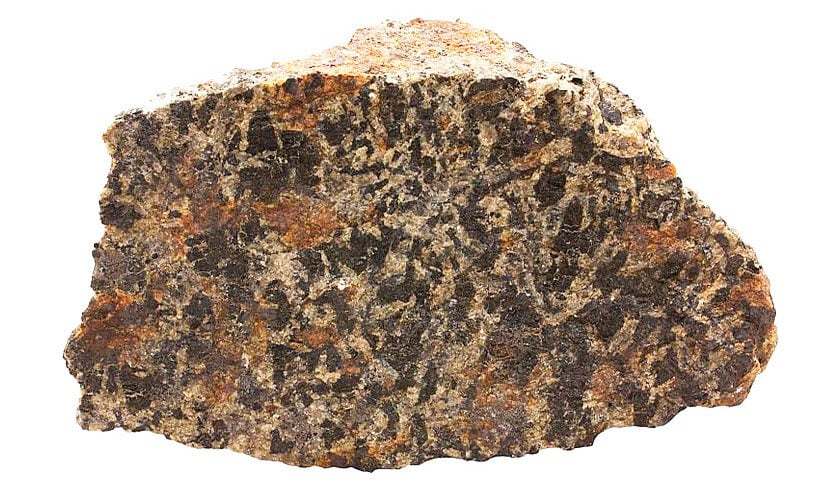
Gabbro isn’t shy; it’s found in various geologic settings around the world. Its occurrences and distribution provide some intriguing details about the Earth’s geology:
- Oceanic crust: Gabbro holds a prominent place in the oceanic crust, which makes up a significant portion of the Earth’s surface. It forms part of the slow cooling and solidification of mafic magma, erupted at mid-ocean ridges, and intruding into the surrounding oceanic crust.
- Layered Intrusions: Gabbro is a common rock type in layered intrusions. These large bodies of igneous rock form when magma solidifies in horizontal layers over an extended period. Famous layered intrusions include the Bushveld Complex in South Africa, the Stillwater Complex in Montana, USA, and the Skaergaard Intrusion in Greenland.
- Continental crust: Gabbro also makes appearances in the continental crust, typically associated with other mafic and ultramafic rocks.
- Mountain belts: You’ll also find gabbroic rocks in mountain belts and areas of tectonic activity where magmatic intrusions have occurred.
- Island arcs: Island arcs are curved chains of volcanic islands formed at subduction zones, and here too, gabbro can be found.
Gabbro’s Role in Our Lives
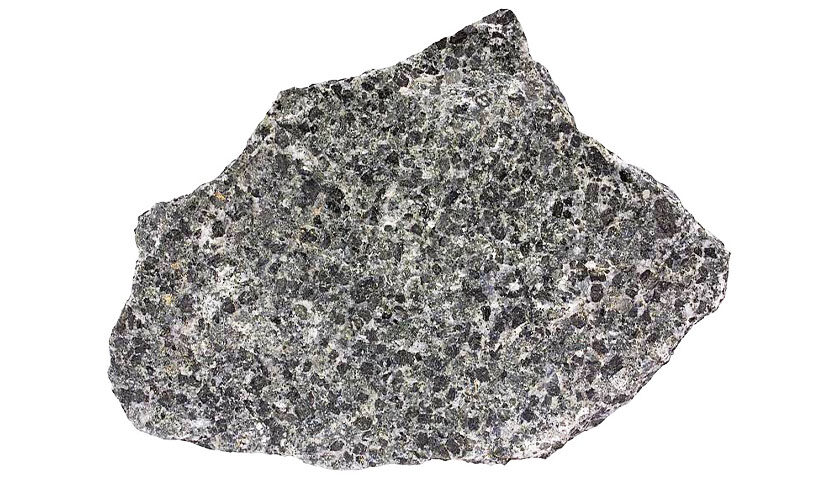
We see and use gabbro in various ways in our everyday lives, though we might not realize it. This rock, which can be polished to a brilliant black luster, is used for cemetery markers, kitchen countertops, floor tiles, and other dimension stone products. It’s highly durable and stands up to weathering and wear, which makes it an excellent choice for various rough-cut products like curbing, ashlars, paving stones, and more.
One of the most common uses of gabbro is as crushed stone or aggregate. It’s used as a base material in construction projects, as a crushed stone for road construction, as railroad ballast, and anywhere a durable crushed stone is needed.
An Unsung Hero of the Ore World
Besides its use in construction and design, gabbro sometimes contains economic amounts of some relatively rare metals. Certain gabbros, for example, contain significant amounts of the mineral ilmenite and are mined for their titanium content. Other gabbros yield nickel, chromium, or platinum.
Indigo Gabbro

Indigo Gabbro, also known as “Mystic Merlinite”, or “Blizzard Stone” is a relatively new mineral discovery that has been getting attention in the gem and mineral world. It’s found in Madagascar and it’s a type of gabbro, an igneous rock. What sets it apart is its remarkable coloring, which can range from light indigo to dark black.
Just like regular gabbro, Indigo Gabbro is made up of several different minerals, including quartz, feldspar, and multiple trace minerals. It has a coarse-grained texture, much like regular gabbro, but the crystal formations tend to be larger, which is one reason for the beautiful mix of colors.
Indigo Gabbro is commonly used as a decorative stone due to its aesthetic appeal. It is cut and polished into various shapes for display purposes, and it can also be made into a variety of jewelry pieces. It is known for having a strong energy, which is why it is also often used in metaphysical practices.
In the stone industry, it might be sold under different names, including “Black Granite.” But keep in mind, despite its commercial name, it’s not a true geological granite.
When it comes to hardness, Indigo Gabbro has a Mohs hardness rating of approximately 5-6, similar to its gabbro counterparts. This makes it relatively resistant to scratching and suitable for various uses, including in jewelry and other decorative items.
A Rock among Rocks
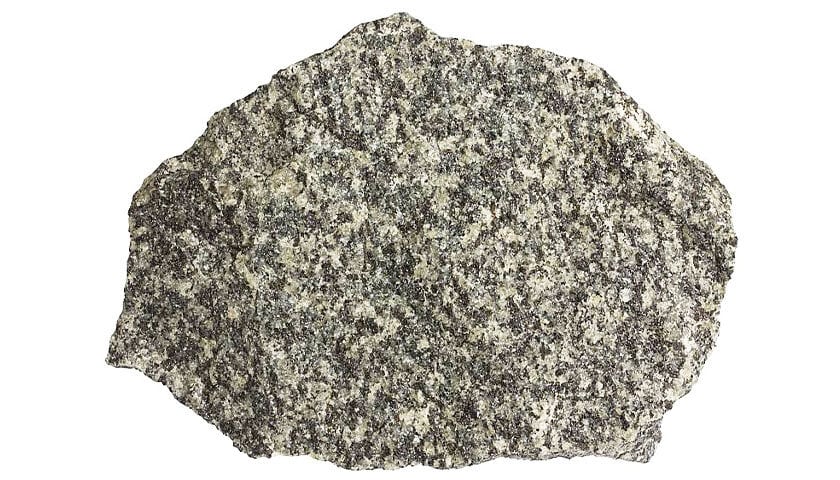
Let’s embark on a geological journey, exploring the differences and similarities between Gabbro and other related rocks. As we delve into these comparisons, you’ll gain an appreciation for the complexity and diversity of the rocky world beneath our feet.
Gabbro vs Basalt
Gabbro and Basalt, two rock stars of the igneous world, share a lot in common. Both of them are mafic rocks, meaning they are rich in iron and magnesium. But here’s the twist: while gabbro forms deep within the Earth’s crust, basalt forms on or very near the surface. This difference in formation leads to a major contrast in their appearances. Gabbro, with its coarse-grained texture and large, visible crystals, is quite distinct from basalt’s fine-grained, almost smooth texture. Think of gabbro as a loaf of artisanal bread with large, discernible grains, while basalt is more like a smooth, finely milled slice of sandwich bread.
Gabbro vs Diorite
Next, let’s compare Gabbro and Diorite. They are both intrusive igneous rocks, meaning they form from magma cooling slowly beneath the Earth’s surface. This results in their coarse-grained texture. However, while gabbro is mafic (rich in iron and magnesium), diorite is intermediate in composition, containing more silica, along with less iron and magnesium. Picture gabbro as a dark, rich chocolate cake while diorite is more of a marble cake, with light and dark swirls.
Gabbro vs Anorthosite
Now, onto Gabbro versus Anorthosite. Gabbro is composed primarily of plagioclase feldspar and pyroxene. Anorthosite, on the other hand, is composed almost entirely of a specific type of plagioclase feldspar: labradorite. They’re both coarse-grained and intrusive but differ in mineral composition. Picture gabbro as a symphony, with the minerals playing together to create its distinctive look, while anorthosite is more like a solo performance by labradorite.
Gabbro vs Norite
Gabbro and Norite share many similarities, but a notable difference is the type of pyroxene they contain. Gabbro primarily contains clinopyroxene (specifically augite), while norite contains orthopyroxene. Both are dark and coarse-grained, but the pyroxene switch leads to subtle differences in appearance and composition.
Gabbro vs Peridotite
Gabbro and Peridotite could be called cousins in the rock family. They both form in the Earth’s mantle but have different mineral compositions. Gabbro is dominantly plagioclase and pyroxene, while peridotite is rich in olivine and, to a lesser extent, pyroxenes. The higher concentration of magnesium and iron gives peridotite a denser and more greenish look compared to gabbro.
Gabbro vs Troctolite
The face-off between Gabbro and Troctolite is a tight one. Both are mafic, coarse-grained intrusive rocks, composed of plagioclase feldspar. But while gabbro also contains pyroxene, troctolite contains olivine. This trade-off subtly changes the rock’s appearance and overall composition.
Gabbro vs Pyroxenite
Finally, let’s look at Gabbro and Pyroxenite. Pyroxenite, an ultramafic rock, is composed almost entirely of pyroxene minerals, while gabbro contains a significant amount of plagioclase feldspar along with pyroxene. Both are coarse-grained, but pyroxenite is darker due to its high pyroxene content.
Frequently Asked Questions About Gabbro
What is Gabbro?
Gabbro is a coarse-grained, dark-colored, intrusive igneous rock. It’s composed mainly of the minerals plagioclase and augite.
Where does the name Gabbro come from?
The term “gabbro” was named after Gabbro, a hamlet in Tuscany, Italy. It was first used in the 1760s to name a set of rock types found in the Apennine Mountains.
What color is Gabbro?
Gabbro is usually black or dark green in color due to its mineral composition, primarily calcium-rich plagioclase feldspar and pyroxenes.
What minerals are in Gabbro?
Gabbro is composed mainly of calcium-rich plagioclase feldspar (usually labradorite or bytownite) and pyroxenes (usually augite). Minor amounts of olivine might also be present in the rock.
How is Gabbro formed?
Gabbro forms through the process of solidification of mafic magma, which is rich in iron and magnesium. This typically occurs at relatively deep levels within the Earth’s crust or upper mantle.
Where can Gabbro be found?
Gabbro is a major rock type in the oceanic crust and can also be found in the continental crust, mountain belts, island arcs, and layered intrusions.
How does Gabbro differ from Basalt?
While both are mafic rocks, Gabbro is coarse-grained and formed from slow cooling magma beneath the Earth’s surface. Basalt, on the other hand, is fine-grained and forms from rapidly cooling lava on the Earth’s surface.
What are the uses of Gabbro?
Gabbro is used for everything from crushed stone base materials at construction sites to polished stone countertops and floor tiles. It’s also used in the dimension stone industry, often sold under the name “black granite”.
Can Gabbro be used as an ore?
Yes, some gabbros containing significant amounts of the mineral ilmenite are mined for their titanium content. Other gabbros can yield nickel, chromium, or platinum.
How can I identify Gabbro?
Gabbro is identified by its dark color and coarse-grained texture. It’s composed mainly of plagioclase feldspar and pyroxenes, and usually lacks quartz.
hat is the hardness of Gabbro?
The hardness of gabbro is around 6 on the Mohs hardness scale, which is similar to the hardness of a steel nail or a piece of glass.
Is Gabbro magnetic?
Gabbro itself is not magnetic, but it can contain small amounts of magnetite, a magnetic mineral. This could give a weakly magnetic character to some gabbro rocks.
Is Gabbro an acid or basic rock?
Gabbro is considered a basic or alkaline rock. This is because it’s rich in minerals like plagioclase and pyroxene, which are high in iron, magnesium, and calcium.
Is Gabbro a volcanic rock?
Gabbro is not a volcanic rock but an intrusive igneous rock, which means it forms from magma that cools and solidifies beneath the Earth’s surface.
Can Gabbro contain fossils?
No, Gabbro, like all igneous rocks, does not contain fossils. The high temperatures of the magma from which it forms would destroy any organic material.
What is ‘Black Granite’?
‘Black Granite’ is actually a commercial name for Gabbro used in the dimension stone industry.
Is Gabbro rare?
No, Gabbro is one of the most common rock types in the deep oceanic crust.
What is ‘Eucrite’?
Eucrite is a type of meteorite that has a similar composition to gabbro and basalt.
Is Gabbro the same as diorite?
No, Gabbro and Diorite are both intrusive igneous rocks, but they differ in their mineral composition. Gabbro is rich in calcium-plagioclase and pyroxene, while Diorite is richer in sodium-plagioclase and hornblende.
Does Gabbro react to acid?
Gabbro does not typically react with acid, unlike rocks such as limestone which fizz or effervesce when they come into contact with acid.
Is Gabbro a plutonic rock?
Yes, Gabbro is a type of plutonic rock, which means it forms from magma that cools and solidifies deep beneath the Earth’s surface.
How does Gabbro rank in the Bowen’s reaction series?
Gabbro forms from the first minerals to crystallize from mafic magma according to Bowen’s Reaction Series. This includes olivine, pyroxene, and calcium-rich plagioclase feldspar.
What is the parent rock of Gabbro?
The parent rock of Gabbro is basaltic magma.
Can Gabbro be metamorphosed?
Yes, when subjected to heat and pressure, Gabbro can metamorphose into a type of rock known as eclogite.
Can Gabbro be found on other planets?
Yes, rocks similar to Gabbro have been found on the Moon and Mars, as well as in meteorites from the asteroid belt.
| Gabbro Physical Properties | |
|---|---|
| Rock Type | Igneous (intrusive) |
| Color | Black, dark green |
| Grain Size | Coarse-grained |
| Texture | Phaneritic (large, visible crystals) |
| Hardness (Mohs scale) | Around 6 |
| Luster | Vitreous to dull |
| Cleavage | None |
| Fracture | Conchoidal to uneven |
| Specific Gravity | Approximately 2.9 to 3.0 |
| Streak | White |
| Magnetism | Generally not magnetic, but can contain magnetite which is magnetic |
| Acid Reaction | Does not react to acid |
| Transparency | Opaque |
| Composition | Primarily calcium-rich plagioclase and pyroxene |
| Weathering Rate | Slow |



